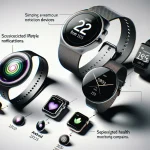
Estimated reading time: 8 minutes
Key Takeaways
- AR Revolutionizes Retail: Augmented Reality merges digital and physical shopping, transforming customer experiences.
- Enhanced Visualization: Customers can visualize products in their own space and try items virtually.
- Significant Benefits: Retailers see increased conversion rates and reduced returns with AR implementation.
- Implementation Considerations: Investment, training, and customer education are key for successful AR adoption.
- Future Trends: Integration with AI, social shopping, and advanced mobile AR experiences are on the horizon.
Table of Contents
- Introduction
- The Rise of Interactive Shopping Through AR Technology
- Understanding AR's Role in Modern Retail
- How AR Transforms the Shopping Experience
- Measurable Benefits for Retailers and Shoppers
- Real-World Success Stories
- Overcoming Implementation Challenges
- Future Trends and Opportunities
- Making AR Work for Your Retail Business
- Conclusion
- Frequently Asked Questions
Introduction
Augmented Reality (AR) is rapidly transforming the retail landscape, revolutionizing how consumers interact with products and brands. By seamlessly blending digital experiences with physical environments, AR creates immersive shopping experiences that enhance customer engagement and satisfaction.
The Rise of Interactive Shopping Through AR Technology
Augmented Reality in retail is transforming how we shop by blending digital experiences with physical environments. Through smartphones and AR devices, customers can now visualize products in their own space, try items virtually, and make more informed purchasing decisions. This technology creates an interactive bridge between online and in-store shopping, offering unprecedented convenience and engagement.
Understanding AR's Role in Modern Retail
AR technology operates by overlaying digital content onto real-world environments in real-time. This creates immersive shopping experiences where customers can:
- View 3D product models in their actual space
- Test different product variations instantly
- Access detailed product information through visual scanning
- Receive personalized recommendations based on preferences
The technology combines computer vision, spatial mapping, and mobile hardware to deliver seamless shopping experiences across various platforms and devices.
How AR Transforms the Shopping Experience
Virtual try-ons stand out as one of AR's most practical applications in retail. Shoppers can see how clothing, accessories, or makeup look on them before purchasing. This feature shines in online shopping, where uncertainty about fit and appearance often prevents purchases.
For home furnishing and décor, AR enables customers to:
- Place virtual furniture in their rooms
- Test different color schemes
- Measure spaces accurately
- Visualize complete room layouts
Measurable Benefits for Retailers and Shoppers
Recent data shows compelling advantages of implementing AR in retail:
For Retailers:
- 94% increase in conversion rates for products with AR features
- 71% of consumers prefer shopping with retailers offering AR experiences
- Significant reduction in product returns due to better pre-purchase visualization
For Consumers:
- 98% of shoppers report AR helps them make better buying decisions
- Reduced purchase anxiety through virtual testing
- Time savings from virtual try-ons and product visualization
Real-World Success Stories
Major retailers implementing AR have seen remarkable results. IKEA's Place app allows customers to visualize furniture in their homes before buying, while Sephora's Virtual Artist enables makeup testing through AR. Nike Fit uses AR technology to help customers find their perfect shoe size, reducing returns and increasing customer satisfaction.
Overcoming Implementation Challenges
While AR offers significant advantages, retailers should consider several factors:
- Initial technology investment and integration costs
- Staff training requirements
- Customer education needs
- Data privacy and security considerations
Successful implementation often involves starting with pilot programs and gathering user feedback before full-scale deployment. Consider reviewing data privacy and security considerations when implementing AR solutions.
Future Trends and Opportunities
The AR retail market shows promising growth, projected to reach $10.5 billion by 2029. Key trends include:
- Integration with AI for enhanced personalization
- Social shopping features powered by AR
- Advanced virtual try-on capabilities
- Improved mobile AR experiences
By 2025, 80% of retailers plan to incorporate AR into their customer experience strategies, indicating widespread adoption across the industry.
Making AR Work for Your Retail Business
To successfully implement AR in retail:
- Start with clear objectives and measurable goals
- Choose user-friendly AR solutions that integrate with existing systems
- Train staff thoroughly on AR features and benefits
- Gather and act on customer feedback
- Monitor performance metrics to optimize AR experiences
This revolutionary technology continues to reshape retail, offering exciting possibilities for both businesses and consumers. As AR technology advances, we can expect even more innovative applications that further enhance the shopping experience.
[Sources: BrandXR Research Report 2025, Imagine.io AR Trends, Amra & Elma AR Marketing Statistics, The Business Research Company Insights]
Conclusion
Augmented Reality is revolutionizing the retail industry by providing immersive and personalized shopping experiences. Retailers embracing AR technology are witnessing increased customer engagement, higher conversion rates, and reduced returns. As AR continues to evolve, it presents endless opportunities for innovation and growth in the retail sector.
Frequently Asked Questions
How does Augmented Reality enhance the retail shopping experience?
Augmented Reality enhances the retail shopping experience by allowing customers to visualize products in their own environment, try on items virtually, and access detailed product information instantly, leading to more informed purchasing decisions.
What are the benefits of AR for retailers?
AR provides retailers with increased conversion rates, higher customer engagement, reduced product returns, and valuable insights into customer preferences and behaviors.
What challenges might retailers face when implementing AR?
Retailers may face challenges such as initial technology investment costs, the need for staff training, customer education, and addressing data privacy and security concerns.
How is AR expected to evolve in the future of retail?
AR is expected to integrate more with AI for personalization, enhance social shopping experiences, offer advanced virtual try-on capabilities, and improve mobile AR experiences.
How can retailers start implementing AR in their business?
Retailers can start by setting clear objectives, choosing user-friendly AR solutions, training their staff, gathering customer feedback, and monitoring performance metrics to optimize their AR experiences.









